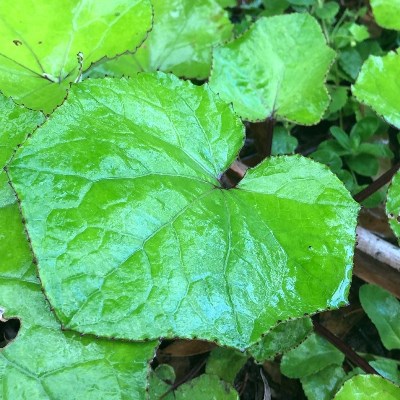Coltsfoot, Tussilago farfara
This little perennial herb grows in my medicinal garden. I first planted it with the purpose of making coltsfoot candies to relieve sore throats. Coltsfoot was grown as a cough remedy by the Romans. They made it into an herbal tea. It’s also known that the leaves could be dried and smoked. But, as Ive done more research into it, I find that I rarely use it medicinally.
And here’s the reason. The leaves and in particular, the flowers, are high in Pyrrolizidine alkaloids. These compounds are the same ones that give uncooked elderflower and elderberries a bad rap. When consumed, they come into contact with bile in the gut and are transformed into toxins that can cause liver toxicity.
So, while you are unlikely to find Coltsfoot products in Australia as it’s restricted for general use, you can find coltsfoot candy in the UK where it will help to relieve a sore throat. (Do not use it while pregnant or nursing.) It’s not a delicious flavour on its own, but is usually mixed with licorice. Licorice root is a naturally sweet herb and is a great relief for sore throats.

Growing Coltsfoot
It’s rhizomatous roots spread slowly through the moist, shady pathway and under the leaf matter, the attractive round leaves popping up in whorls in spring and summer. It doesn’t flower in our garden, as it seems that the yellow flowers are held back for a cooler spot than our subtropical acreage.
Apart from the limited medicinal uses, there are other uses for Coltsfoot. I have a wonderful book by Robert Kourik called ‘Designing and maintaining your edible landscape naturally’. In this, he outlines how Coltsfoot is a dynamic accumulator. That’s a plant that ‘amass[es] a greater than usual amount of a particular nutrient in their foliage’.
Coltsfoot is a dynamic accumulator of Sulphur, Magnesium, Calcium, Potassium, Iron and Copper. And it’s interesting to note that in times gone by before artificially produced or mass-produced factory fertilisers were available, potassium accumulator plants including bracken fern, were dried or burnt and the ash used as potash to correct soil and plant deficiencies.
If you would like a Coltsfoot plant, I do have some for sale from time to time. Email me to order and collect your plant.



